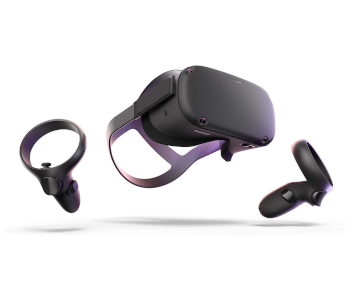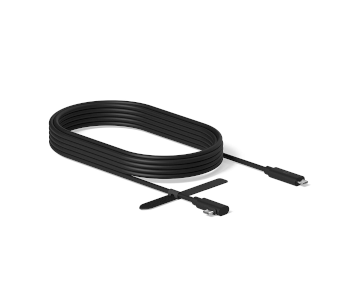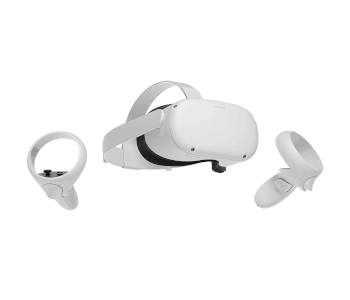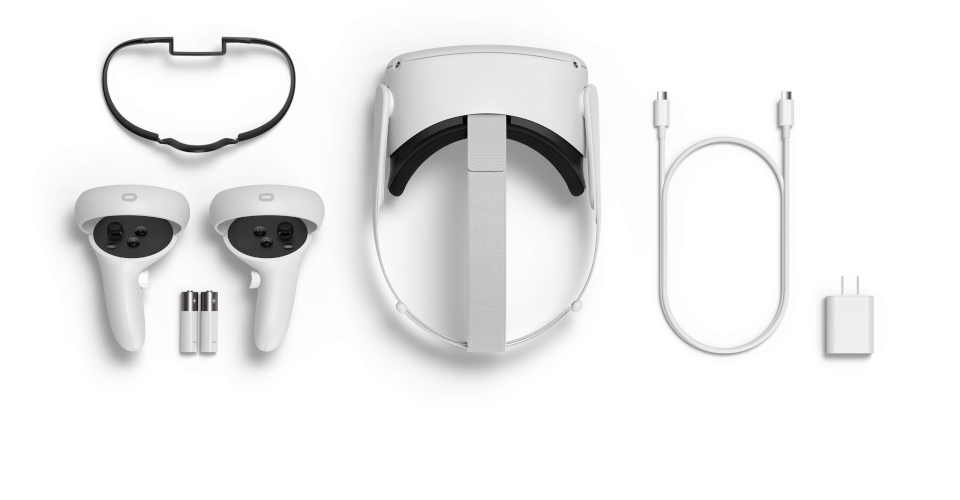Oculus Quest 2: Standalone VR On the Go Exceeds Expectations
The Oculus Quest 2 was released just a few days ago, at a time when just about every single person is starving for news they can get excited about. Thus, it comes as no surprise that the initial response was mostly positive.
Now that the hype has somewhat died down and we can make a more sober look at the product, let’s ask again – is the Oculus Quest 2 a worthwhile descendant of its predecessor? Does it offer anything new which might bring VR entertainment to a more mainstream audience?
A look back: the original Oculus Quest

The original Oculus Quest was launched in 2019, right alongside the Oculus Rift S. Both VR headsets were launched at exactly the same price but had vastly different approaches to their intended use case. The Oculus Rift S was a classic Rift – a wired headset which was intended to hook up to a gaming PC.
The first Oculus Quest was unique in that it was a wireless, fully self-contained VR headset with its own graphics processor and a dedicated library of Quest-exclusive VR experiences. While this made the Quest nifty enough, the wireless VR headset received a huge upgrade in late 2019 via Oculus Link.
With the Oculus Link allowed the Quest to hook up to a gaming PC using a standard USB-C connector. This effectively turned the Quest into a standard Rift-type wired VR headset.
Although the Quest version of the Rift experience suffered from a bit of latency and downgraded video quality, the ability to convert from wired to wireless was lauded by money. It was also a huge boost for the Quest, making it one of the more successful VR headsets ever produced by Oculus.
Considering how good the reception for the Quest was, it was understandable that people were excited for the Quest 2. Did the Oculus Quest 2 live up to these lofty expectations?
Build quality and design
The Oculus Quest 2 is determined to be as visually distinct from its predecessor, going for an all-white color scheme in contrast to the original’s black. The headset is shaped similarly, although it’s a little smaller and about 10% lighter (at 17.7 ounces) compared to the original Quest.
A major change in the Oculus Quest 2 is the move to have only flexible straps, instead of the hard straps of the first Quest. This can get a bit of getting used to but can eventually be adjusted to be comfortably snug. We imagine that the flexible straps have also helped keep the weight of the headset down. Even with the reduced weight, the Quest 2 still feels a little front-heavy.
If you prefer more stability, Oculus sells an Elite Strap for the Quest 2 with a rigid hard strap and a convenient adjustment wheel. The strap option costs $49 at launch.
The stock eye padding that comes with the Quest 2 feels comfortable enough and slightly better than those of the original Quest. If you need pads that are narrower or wider, Oculus sells a pack of alternate facial interfaces with light blockers.
Performance

Taking a look under the hood, we can see that the Oculus Quest 2 comes with a Qualcomm Snapdragon XR2 graphics processor. This represents a few generations’ worth of upgrades from the Snapdragon 835 GPU of the original Oculus Quest.
The Oculus Link is back in the Quest 2 as a standard feature and not just an upgrade. With this, the USB-C port of the Quest 2 has been relocated in a much more sensible position to allow for tethered use. Oculus sells an official 5-meter Link cable for $79, designed specifically for this purpose.
The resolution of the screens of the Quest 2 has also been upgraded to 1832 x 1920 per eye (the previous Quest had 1400 x 1600), although this second-generation headset shifted back to LCD from OLED. The downgrade isn’t all that apparent, though, given how huge the boost in resolution is. The screens of the Quest 2 have noticeably reduced the screen door effect, as well as the halo on the edge of the video display.
At launch, the screens of the Quest 2 will have a refresh rate of 72 Hz, the same as its predecessor. Oculus has promised that a future update will bump this up to 90 Hz. This will put it at par with most PC-tethered headsets, so that’s certainly an update we’re looking forward to.
Overall, the upgrades in the graphical processor and the video display have made a huge improvement in the overall VR experience. The graphics look significantly more polished with reduced grainy artifacts. As with the original, the battery of the Oculus Quest 2 lasts for anywhere between 2 to 2.5 hours for each cycle. This feels plenty for a VR gaming session.
The head tracking of the Quest 2 is excellent as usual, with its four cameras scanning the environment to determine your location. These cameras also track the movement of the handheld controllers. Coupled with the internal sensors, this tracking system provides real six degrees of freedom (6DoF).
As a side note, the Oculus Quest 2 has a standard provision for interpupillary distance (IPD) adjustment. The only problem is that you have to remove the headset to swap between any of the three settings, instead of just having a wheel you can rotate while you have the headset on. This isn’t a huge problem if you’re the only one using the headset but is a slight inconvenience if you tend to pass the headset around between other people in your house.
Audio
Just like the first Quest, the Quest 2 does not have built-in headphones. Instead, it has built-in speakers for ambient spatial audio. This is probably a move to keep the cost of the headset down, but one can’t help but be miffed with the lack of good options if you don’t like bothering the rest of your house with the audio of your video games.
The good news is that the headset comes with a standard 3.5-mm jack. However, that means having to plug in a pair of wired earbuds, which aren’t the best in terms of audio immersion. There’s also the dissonance of having to use wired earbuds in a headset that was designed to be used wireless.
Unfortunately, the Oculus Quest 2 provides no Bluetooth audio support. This means that any of the options available for audio are less than ideal – it’s either you lack privacy or have to deal with wired earbuds.
Controllers
The Oculus Touch controllers that come with the Quest 2 are essentially the same ones as that of the first Quest, with just a few minor upgrades. The trigger, grip, and face buttons are still there, but the controller has a wider finger rest. The added heft makes the controllers feel just a little more premium.
The handheld controllers use AA batteries, the same as the previous generation. Built-in rechargeable batteries would have been better, although Oculus says that the controllers have been optimized to last four times as long. In any case, these controllers last a really long time, especially considering the battery limitations of the headset itself.
The Quest 2 also uses its cameras for hand-tracking features. This technology detects your fingertips, using them as proxy controllers. This is still a fairly immature technology, so controlling anything with your hands can still feel janky as some of your movements and gestures aren’t detected perfectly. However, there is so much potential for this “controller-free” control scheme. We can’t wait for it to get better!
Content

The Quest 2 benefits from more than a year of content development for the original Quest, instantly providing it a library of more than 500 VR titles. Even better is the fact that some Quest games have been upgraded to take advantage of the more powerful processor of the Quest 2. Naturally, we expect this library to continue growing for the next few months or years.
As VR entertainment becomes more common, we expect VR content to mature beyond a library composed mostly of games. We already have VR fitness apps, theaters with 360 videos, and tools for VR socialization. Spatial is a popular example of this new VR experience, providing a virtual environment for professional meetings – a sort of “virtual workplace,” if you will.
Aside from the dedicated Quest library, let’s not overlook the fact that the Quest 2 can connect to a gaming PC via Oculus Link. This means that it can be used to play PC-based VR games from Steam. This instantly multiplies the amount of content that you can experience with the Quest 2.
No matter if you play wired or wireless, one thing is for sure – lack of content will no longer be a problem for the Oculus Quest 2. That’s a hurdle that VR technology has crossed thru multiple hardware generations.
No review for the Oculus Quest 2 would be complete without talking about the elephant in the room – Facebook connectivity. The Quest 2 now requires that you sign in with a Facebook account before you can use it. If you have an existing Oculus account, then you’ll have to link your Facebook account to it.
This seems to be the first time that the Oculus experience has been directly influenced by the fact that Facebook owns the company. Just to be clear, Facebook had already been collecting data through Oculus in the previous generations. However, this is the first time that users of Oculus headsets had to agree with Facebook’s data policy and terms of service.
There are a lot of concerns about what this could mean for Oculus users. On the less malicious side, this means that your VR gaming behavior will be used to “learn” about you for more directed ads. We won’t be surprised to see ads about VR games and experiences in our Facebook feed after a few gaming sessions.
There’s also the fact that all of the VR experiences you will buy will be as digital content. Should your Facebook account be flagged or banned because of violations in your social media channel, does that mean that you lose access to your digital library?
Facebook hasn’t directly addressed these concerns yet, but that’s pretty much par for the course for this social media giant. With this increasing Facebook involvement, we may yet see more VR experiences that take advantage of social media communities. Will this be the push that makes VR headsets more mainstream? The current climate of social distancing just might be the perfect environment to introduce such an idea.
Price
Two versions of the Oculus Quest 2 are available – a 64 GB version that costs $299 and a 256 GB version that costs $399. The Quest 2 has no expandable memory, so there’s no option to increase the storage capacity of these headsets. Considering how VR experiences rarely go beyond 4 GB, even the 64 GB version provides plenty of space for your favorites.
At $299, the 64-GB Quest 2 is already $100 less than the cost of the original Oculus Quest back when it was announced. The first Quest was a huge hit, so we fully expect this 2nd generation version to be similarly successful especially since it’s even cheaper.
This price disparity is even more apparent if we compare the Oculus Quest 2 with PC-tethered headsets like the HTC Vive. Even if you went and bought the optional Oculus Link cable and Elite Strap, the Quest 2 will still come out less expensive.
Final thoughts
The Oculus Quest 2 is not a perfect VR headset, but it improves on the Oculus Quest so much that it’s easily a compelling purchase. The ergonomics of the headset are a bit questionable, and you may need to buy extra accessories to make it more comfortable for you. However, it cannot be denied that the more powerful processor and high-resolution screen vastly improve the VR experience.
The Oculus Link feature, introduced in the 1st generation Quest, is back and here to stay. It effectively turns the wireless headset into a standard PC-tethered headset, instantly expanding the number of VR games and experiences that you can access.
A quick warning, though – switching back to tethered can feel awkward once you’ve gotten used to playing VR games wireless.
What makes the Quest 2 the perfect gateway product to VR entertainment is the fact that it’s very inexpensive. This is the cheapest that a standalone VR headset from a major brand has been launched. If you’ve never owned a VR headset before, you can’t go wrong with the Quest 2.
The problematic thing about the Quest 2 is how it requires you to log in and connect with your Facebook account. Your mileage may vary, but both seasoned VR users and newbies have expressed concerns about this newly introduced log-in feature.
In the past years, Facebook has been bombarded with issues on privacy and data security, so a bit of wariness is healthy. Still, some people may argue that these concerns seem abstract or immaterial compared to the quality of the Quest 2 as a VR headset. As long as this little hiccup isn’t a deal-breaker for you, then the Oculus Quest 2 is easily the most widely appealing VR headset that we’ve seen in recent years.


